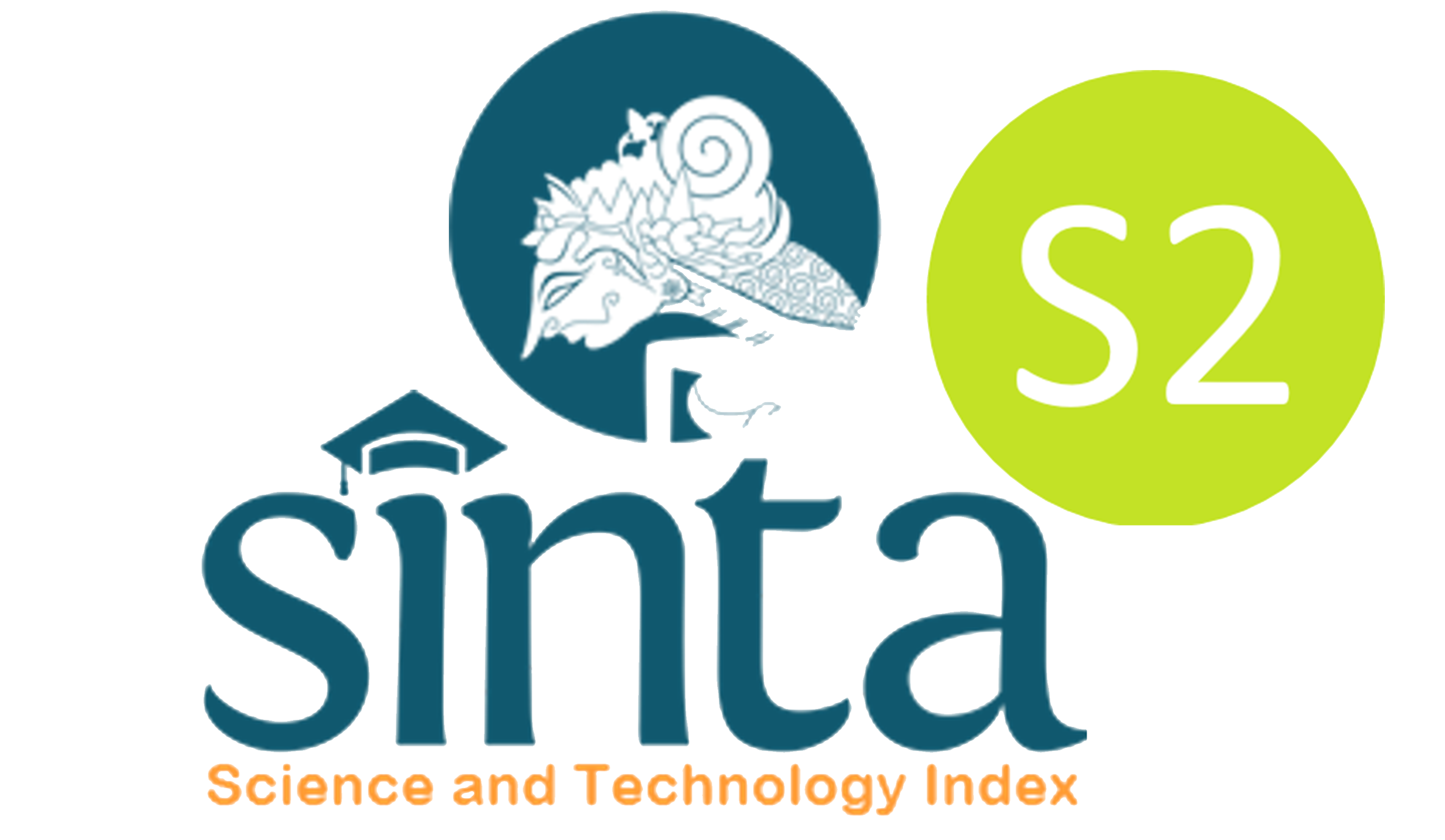A Correlation Method for Meteorological Factors and Air pollution in association to covid-19 pandemic in the most affected city in Indonesia
Nurilmiyanti Wardhani(1); Hamdan Gani(2); Sitti Zuhriyah(3*); Helmy Gani(4); Etika Vidyarini(5);
(1) STMIK Handayani Makassar
(2) STMIK Handayani Makassar
(3) STMIK Handayani Makassar
(4) Akademi Hiperkes
(5) Institut Teknologi Bandung
(*) Corresponding Author
AbstractThis study aims to validate the correlation between meteorological factors and air pollution with the spread of Covid-19 in Jakarta, Indonesia. This study examined the Covid-19 cases of Jakarta and its five municipalities. The secondary data of Covid-19 cases, includes Daily Positive Cases (DPC) and Total Daily Positive Cases (TDPC), were retrieved from the Health Office of DKI Jakarta Province, while the meteorological and air pollution parameters were obtained from the online database archives. Kendall and Spearman rank correlation tests were used to analyze correlation between DPC and TDPC with meteorological and air pollution parameters. This study found that Air Quality Index and PM10 showed a significant positive correlation with DPC in municipalities of Jakarta. Also, the average air temperature was positively correlated to TDPC in all region of Jakarta. Average air temperature, Air Quality Index, and PM10 were the factors that take into account for the spread of Covid-19 pandemic in Jakarta, Indonesia. The warmer temperature associated to the higher number of case. Thus, there are no indications that the spread of Covid-19 in subtropical or temperate country may decrease when entering a warmer season that resembles the climatic characteristics in tropical region. Additionally, the significance of air pollutant factors implies that reducing air pollution should be promoted as it might reduce the spread of Covid-19. The findings of this study would be useful to support the strategy and policy in preventing the spread of Covid-19 in the country.
KeywordsCovid-19; Meteorological Factors; Air Pollution; Tropical Climate; Indonesia
|
Full Text:PDF |
Article MetricsAbstract view: 772 timesPDF view: 212 times |
Digital Object Identifier https://doi.org/10.33096/ilkom.v13i3.854.195-205 https://doi.org/10.33096/ilkom.v13i3.854.195-205
|
Cite |
References
M. A. Shereen, S. Khan, A. Kazmi, N. Bashir, and R. Siddique, COVID-19 infection: Origin, transmission, and characteristics of human coronaviruses, Journal of Advanced Research, vol. 24, pp. 9198, 2020, doi: 10.1016/j.jare.2020.03.005.
Y. Chen, Q. Liu, and D. Guo, Emerging coronaviruses: Genome structure, replication, and pathogenesis, Journal of Medical Virology, vol. 92, no. 4, pp. 418423, Apr. 2020, doi: 10.1002/jmv.25681.
C. C. Lai, T. P. Shih, W. C. Ko, H. J. Tang, and P. R. Hsueh, Severe acute respiratory syndrome coronavirus 2 (SARS-CoV-2) and coronavirus disease-2019 (COVID-19): The epidemic and the challenges, International Journal of Antimicrobial Agents, vol. 55, no. 3, p. 105924, 2020, doi: 10.1016/j.ijantimicag.2020.105924.
WHO, Coronavirus disease 2019 (COVID-19) situation report 41. Retrieved from., 2020. https://www.who.int/docs/default-source/coronaviruse/situation-reports/%0A20200301-sitrep-41-covid-19.pdf?sfvrsn=6768306d_2. (accessed Jul. 14, 2020).
A. Altamimi and A. E. Ahmed, Climate factors and incidence of Middle East respiratory syndrome coronavirus, Journal of Infection and Public Health, vol. 13, no. 5, pp. 704708, 2020, doi: 10.1016/j.jiph.2019.11.011.
Q. C. Cai et al., Influence of meteorological factors and air pollution on the outbreak of severe acute respiratory syndrome, Public Health, vol. 121, no. 4, pp. 258265, 2007, doi: 10.1016/j.puhe.2006.09.023.
A. I. Barreca, Climate change, humidity, and mortality in the United States, Journal of Environmental Economics and Management, vol. 63, no. 1, pp. 1934, Jan. 2012, doi: 10.1016/j.jeem.2011.07.004.
A. I. Barreca and J. P. Shimshack, Absolute humidity, temperature, and influenza mortality: 30 years of county-level evidence from the united states, American Journal of Epidemiology, vol. 176, no. SUPPL. 7, pp. S114S122, 2012, doi: 10.1093/aje/kws259.
R. E. Davis, E. Dougherty, C. McArthur, Q. S. Huang, and M. G. Baker, Cold, dry air is associated with influenza and pneumonia mortality in Auckland, New Zealand, Influenza and other Respiratory Viruses, vol. 10, no. 4, pp. 310313, 2016, doi: 10.1111/irv.12369.
N. Van Doremalen et al., Aerosol and surface stability of SARS-CoV-2 as compared with SARS-CoV-1, New England Journal of Medicine, vol. 382, no. 16, pp. 15641567, 2020.
L. M. Casanova, S. Jeon, W. A. Rutala, D. J. Weber, and M. D. Sobsey, Effects of air temperature and relative humidity on coronavirus survival on surfaces, Applied and Environmental Microbiology, vol. 76, no. 9, pp. 27122717, 2010, doi: 10.1128/AEM.02291-09.
N. Pica and N. M. Bouvier, Environmental factors affecting the transmission of respiratory viruses, Current Opinion in Virology, vol. 2, no. 1, pp. 9095, 2012, doi: 10.1016/j.coviro.2011.12.003.
J. S. Kutter, M. I. Spronken, P. L. Fraaij, R. A. Fouchier, and S. Herfst, Transmission routes of respiratory viruses among humans, Current Opinion in Virology, vol. 28, pp. 142151, 2018, doi: 10.1016/j.coviro.2018.01.001.
K. H. Chan, J. S. M. Peiris, S. Y. Lam, L. L. M. Poon, K. Y. Yuen, and W. H. Seto, The effects of temperature and relative humidity on the viability of the SARS coronavirus, Advances in Virology, vol. 2011, 2011, doi: 10.1155/2011/734690.
S. Gupta, G. S. Raghuwanshi, and A. Chanda, Effect of weather on COVID-19 spread in the US: A prediction model for India in 2020, Science of the Total Environment, vol. 728, p. 138860, 2020, doi: 10.1016/j.scitotenv.2020.138860.
M. F. Bashir et al., Correlation between climate indicators and COVID-19 pandemic in New York, USA, Science of the Total Environment, vol. 728, p. 138835, 2020, doi: 10.1016/j.scitotenv.2020.138835.
M. Ahmadi, A. Sharifi, S. Dorosti, S. Jafarzadeh Ghoushchi, and N. Ghanbari, Investigation of effective climatology parameters on COVID-19 outbreak in Iran, Science of the Total Environment, vol. 729, p. 138705, 2020, doi: 10.1016/j.scitotenv.2020.138705.
. Briz-Redn and . Serrano-Aroca, A spatio-temporal analysis for exploring the effect of temperature on COVID-19 early evolution in Spain, Science of the Total Environment, vol. 728, p. 138811, 2020, doi: 10.1016/j.scitotenv.2020.138811.
M. M. Menebo, Temperature and precipitation associate with Covid-19 new daily cases: A correlation study between weather and Covid-19 pandemic in Oslo, Norway, Science of the Total Environment, vol. 737, p. 139659, 2020, doi: 10.1016/j.scitotenv.2020.139659.
M. ?ahin, Impact of weather on COVID-19 pandemic in Turkey, Science of the Total Environment, vol. 728, p. 138810, 2020, doi: 10.1016/j.scitotenv.2020.138810.
B. Oliveiros, L. Caramelo, N. C. Ferreira, and F. Caramelo, Role of temperature and humidity in the modulation of the doubling time of COVID-19 cases, medRxiv, p. 2020.03.05.20031872, 2020, doi: 10.1101/2020.03.05.20031872.
P. Shi et al., Impact of temperature on the dynamics of the COVID-19 outbreak in China, Science of the Total Environment, vol. 728, p. 138890, 2020, doi: 10.1016/j.scitotenv.2020.138890.
H. Xu et al., Possible environmental effects on the spread of COVID-19 in China, Science of the Total Environment, vol. 731, p. 139211, 2020, doi: 10.1016/j.scitotenv.2020.139211.
H. Qi et al., COVID-19 transmission in Mainland China is associated with temperature and humidity: A time-series analysis, Science of the Total Environment, vol. 728, p. 138778, 2020, doi: 10.1016/j.scitotenv.2020.138778.
J. Liu et al., Impact of meteorological factors on the COVID-19 transmission: A multi-city study in China, Science of the Total Environment, vol. 726, p. 138513, 2020, doi: 10.1016/j.scitotenv.2020.138513.
Y. Ma et al., Effects of temperature variation and humidity on the death of COVID-19 in Wuhan, China, Science of the Total Environment, vol. 724, p. 138226, 2020, doi: 10.1016/j.scitotenv.2020.138226.
J. Xie and Y. Zhu, Association between ambient temperature and COVID-19 infection in 122 cities from China, Science of the Total Environment, vol. 724, p. 138201, 2020, doi: 10.1016/j.scitotenv.2020.138201.
W. Luo et al., The role of absolute humidity on transmission rates of the COVID-19 outbreak, medRxiv, p. 7, 2020, doi: 10.1101/2020.02.12.20022467.
M. Wang et al., Temperature significant change COVID-19 Transmission in 429 cities, medRxiv, p. 2020.02.22.20025791, 2020, doi: 10.1101/2020.02.22.20025791.
Y. Wu et al., Effects of temperature and humidity on the daily new cases and new deaths of COVID-19 in 166 countries, Science of the Total Environment, vol. 729, p. 139051, 2020, doi: 10.1016/j.scitotenv.2020.139051.
M. F. F. Sobral, G. B. Duarte, A. I. G. da Penha Sobral, M. L. M. Marinho, and A. de Souza Melo, Association between climate variables and global transmission oF SARS-CoV-2, Science of the Total Environment, vol. 729, p. 138997, 2020, doi: 10.1016/j.scitotenv.2020.138997.
M. M. Sajadi, P. Habibzadeh, A. Vintzileos, S. Shokouhi, F. Miralles-Wilhelm, and A. Amoroso, Temperature and Latitude Analysis to Predict Potential Spread and Seasonality for COVID-19, SSRN Electronic Journal, 2020, doi: 10.2139/ssrn.3550308.
B. Steinfeld et al., The Role of Lean Process Improvement in Implementation of Evidence-Based Practices in Behavioral Health Care, Journal of Behavioral Health Services and Research, vol. 42, no. 4, pp. 504518, 2015, doi: 10.1007/s11414-013-9386-3.
A. Tobas and T. Molina, Is temperature reducing the transmission of COVID-19 ?, Environmental Research, vol. 186, p. 109553, 2020, doi: 10.1016/j.envres.2020.109553.
Y. Yao et al., No association of COVID-19 transmission with temperature or UV radiation in Chinese cities, European Respiratory Journal, vol. 55, no. 5, 2020, doi: 10.1183/13993003.00517-2020.
S. S. Gunthe, B. Swain, S. S. Patra, and A. Amte, On the global trends and spread of the COVID-19 outbreak: preliminary assessment of the potential relation between location-specific temperature and UV index, Journal of Public Health (Germany), pp. 110, 2020, doi: 10.1007/s10389-020-01279-y.
D. N. Prata, W. Rodrigues, and P. H. Bermejo, Temperature significantly changes COVID-19 transmission in (sub)tropical cities of Brazil, Science of the Total Environment, vol. 729, p. 138862, 2020, doi: 10.1016/j.scitotenv.2020.138862.
A. C. Auler, F. A. M. Cssaro, V. O. da Silva, and L. F. Pires, Evidence that high temperatures and intermediate relative humidity might favor the spread of COVID-19 in tropical climate: A case study for the most affected Brazilian cities, Science of the Total Environment, vol. 729, p. 139090, 2020, doi: 10.1016/j.scitotenv.2020.139090.
F. Mndez-Arriaga, The temperature and regional climate effects on communitarian COVID-19 contagion in Mexico throughout phase 1, Science of the Total Environment, vol. 735, p. 139560, 2020, doi: 10.1016/j.scitotenv.2020.139560.
S. K. Pani, N. H. Lin, and S. RavindraBabu, Association of COVID-19 pandemic with meteorological parameters over Singapore, Science of the Total Environment, vol. 740, p. 140112, 2020, doi: 10.1016/j.scitotenv.2020.140112.
R. Tosepu et al., Correlation between weather and Covid-19 pandemic in Jakarta, Indonesia, Science of the Total Environment, vol. 725, p. 138436, 2020, doi: 10.1016/j.scitotenv.2020.138436.
A. Asyary and M. Veruswati, Sunlight exposure increased Covid-19 recovery rates: A study in the central pandemic area of Indonesia, The Science of the total environment, vol. 729, p. 139016, 2020, doi: 10.1016/j.scitotenv.2020.139016.
Y. Zhu, J. Xie, F. Huang, and L. Cao, Association between short-term exposure to air pollution and COVID-19 infection: Evidence from China, Science of the Total Environment, vol. 727, p. 138704, 2020, doi: 10.1016/j.scitotenv.2020.138704.
M. F. Bashir et al., Correlation between environmental pollution indicators and COVID-19 pandemic: A brief study in Californian context, Environmental Research, vol. 187, p. 109652, 2020, doi: 10.1016/j.envres.2020.109652.
J. Xie, J. Teng, Y. Fan, R. Xie, and A. Shen, The short-term effects of air pollutants on hospitalizations for respiratory disease in Hefei, China, International journal of biometeorology, vol. 63, no. 3, pp. 315326, 2019.
B. D. Horne et al., Short-term elevation of fine particulate matter air pollution and acute lower respiratory infection, American journal of respiratory and critical care medicine, vol. 198, no. 6, pp. 759766, 2018.
CNN Indonesia, Jokowi Umumkan Dua WNI Positif Corona di Indonesia CNN Indonesia Senin, 02/03/2020 11:36, CNN Indonesia, 2020. https://m.cnnindonesia.com/nasional/20200302111534-20-479660/jokowi-umumkan-dua-wni-positif-corona-di-indonesia (accessed May 31, 2020).
Kemkes, https://covid-monitoring.kemkes.go.id/, 2020. https://covid-monitoring.kemkes.go.id/ (accessed May 31, 2020).
Data.jakarta.go.id, Data Penduduk DKI Jakarta, 2020. https://data.jakarta.go.id/organization/dinas-kependudukan-dan-catatan-sipil (accessed Jun. 17, 2020).
Timeanddate, Jakarta weather reports during 20052015, 2020. https://www.timeanddate.com/weather/@1642907/climate (accessed Jun. 17, 2020).
Airnow.gov, Air Quality Index. Retrieved from., 2020. https://www.airnow.gov/aqi/aqi-basics/#:~:text=Think of the AQI as,300 represents hazardous air quality. (accessed May 31, 2020).
Airnow.gov, Particulate Matter. Retrieved from., 2020. https://www.airnow.gov/publications/air-quality-and-your-health/partical-pollution-and-your-health/ (accessed May 31, 2020).
The Jakarta Post, PSBB. Retrieved from., 2020. https://www.thejakartapost.com/academia/2020/05/11/in-psbb-we-trust.html.
Y. Yao et al., Association of particulate matter pollution and case fatality rate of COVID-19 in 49 Chinese cities, Science of the Total Environment, vol. 741, p. 140396, 2020, doi: 10.1016/j.scitotenv.2020.140396.
J. Wang, K. Tang, K. Feng, and W. Lv, High Temperature and High Humidity Reduce the Transmission of COVID-19, SSRN Electronic Journal, 2020, doi: 10.2139/ssrn.3551767.
Weather-atlas, Jakarta climate, 2020. https://www.weather-atlas.com/en/indonesia/jakarta-climate (accessed Jun. 17, 2020).
A. A. Chudnovsky, Letter to editor regarding Ogen Y 2020 paper: Assessing nitrogen dioxide (NO2) levels as a contributing factor to coronavirus (COVID-19) fatality, Science of the Total Environment, no. xxxx, p. 139236, 2020, doi: 10.1016/j.scitotenv.2020.139236.
The Jakarta Post, Indonesias climate can limit COVID-19, but high mobility exacerbates it: BMKG, 2020. https://www.thejakartapost.com/news/2020/04/04/indonesias-climate-can-limit-covid-19-but-high-mobility-exacerbates-it-bmkg.html (accessed Jun. 17, 2020).
A. Paez, Using Google Community Mobility Reports to investigate the incidence of COVID-19 in the United States, Transport Findings, pp. 18, 2020, doi: 10.32866/001c.12976.
M. U. G. Kraemer et al., The effect of human mobility and control measures on the COVID-19 epidemic in China, Science, vol. 368, no. 6490, pp. 493497, 2020, doi: 10.1126/science.abb4218.
Tempo, Covid 19 task force head psbb in jakarta is not effective yet, 2020. https://en.tempo.co/read/1333550/covid-19-task-force-head-psbb-in-jakarta-is-not-effective-yet (accessed Jun. 17, 2020).
Kompas, Residents still ignoring psbb, 2020. https://kompas.id/baca/english/2020/04/16/residents-still-ignoring-psbb/ (accessed Jun. 17, 2020).
The Jakarta Post, Ministry allows 11000 companies operate during psbb, 2020. https://www.thejakartapost.com/news/2020/04/22/no-choice-but-to-keep-economy-running-ministry-allows-11000-companies-operate-during-psbb.html (accessed Jun. 17, 2020).
A. Wilder-Smith and D. O. Freedman, Isolation, quarantine, social distancing and community containment: Pivotal role for old-style public health measures in the novel coronavirus (2019-nCoV) outbreak, Journal of Travel Medicine, vol. 27, no. 2, p. taaa020, 2020, doi: 10.1093/jtm/taaa020.
J. Riou and C. L. Althaus, Pattern of early human-to-human transmission of Wuhan 2019 novel coronavirus (2019-nCoV), December 2019 to January 2020, Eurosurveillance, vol. 25, no. 4, p. 2000058, 2020, doi: 10.2807/1560-7917.ES.2020.25.4.2000058.
Z. Wu and J. M. McGoogan, Characteristics of and Important Lessons from the Coronavirus Disease 2019 (COVID-19) Outbreak in China: Summary of a Report of 72314 Cases from the Chinese Center for Disease Control and Prevention, JAMA - Journal of the American Medical Association, vol. 323, no. 13, pp. 12391242, 2020, doi: 10.1001/jama.2020.2648.
WHO, WHO Clinical management of severe acute respiratory infection (SARI) when COVID-19 disease is suspected. Retrieved from., World Health Organization, 2020.
B. E. Young et al., Epidemiologic Features and Clinical Course of Patients Infected with SARS-CoV-2 in Singapore, JAMA - Journal of the American Medical Association, vol. 323, no. 15, pp. 14881494, 2020, doi: 10.1001/jama.2020.3204.
N. Fishman and D. P. Calfee, Prevention and Control of Health Care-Associated Infections, Goldmans Cecil Medicine: Twenty Fourth Edition, vol. 2, no. 2, pp. 17801787, 2011, doi: 10.1016/B978-1-4377-1604-7.00290-6.
Refbacks
- There are currently no refbacks.
Copyright (c) 2021 Nurilmiyanti Wardhani, Hamdan Gani, Sitti Zuhriyah, Helmy Gani, Etika Vidyarini

This work is licensed under a Creative Commons Attribution-ShareAlike 4.0 International License.










